Clinical Practice Guidelines Evaluation on Cholecystitis Management
VerifiedAdded on 2023/05/27
|13
|3282
|466
Report
AI Summary
This report evaluates clinical practice guidelines for cholecystitis, a condition involving gallbladder inflammation due to gallstone obstruction. It discusses the pathophysiology, epidemiology, morbidity, and mortality associated with cholecystitis. The report assesses the clinical practice guideline's effectiveness in addressing the health problem, its basis on recent evidence, and its adequacy in directing healthcare provider management. Various diagnostic methods like ultrasound, HIDA, MRCP, and ERCP are mentioned, along with pharmaceutical interventions such as endogenous bile acids and antiemetics. The evaluation identifies the guideline's strengths in symptom analysis and medication prescription but notes limitations in detailing surgical treatments like laparoscopy. The report concludes with recommendations for revising the guideline to include updated treatment technologies and surgical procedures for comprehensive cholecystitis management. The document is available on Desklib, a platform offering study tools for students, including solved assignments and past papers.
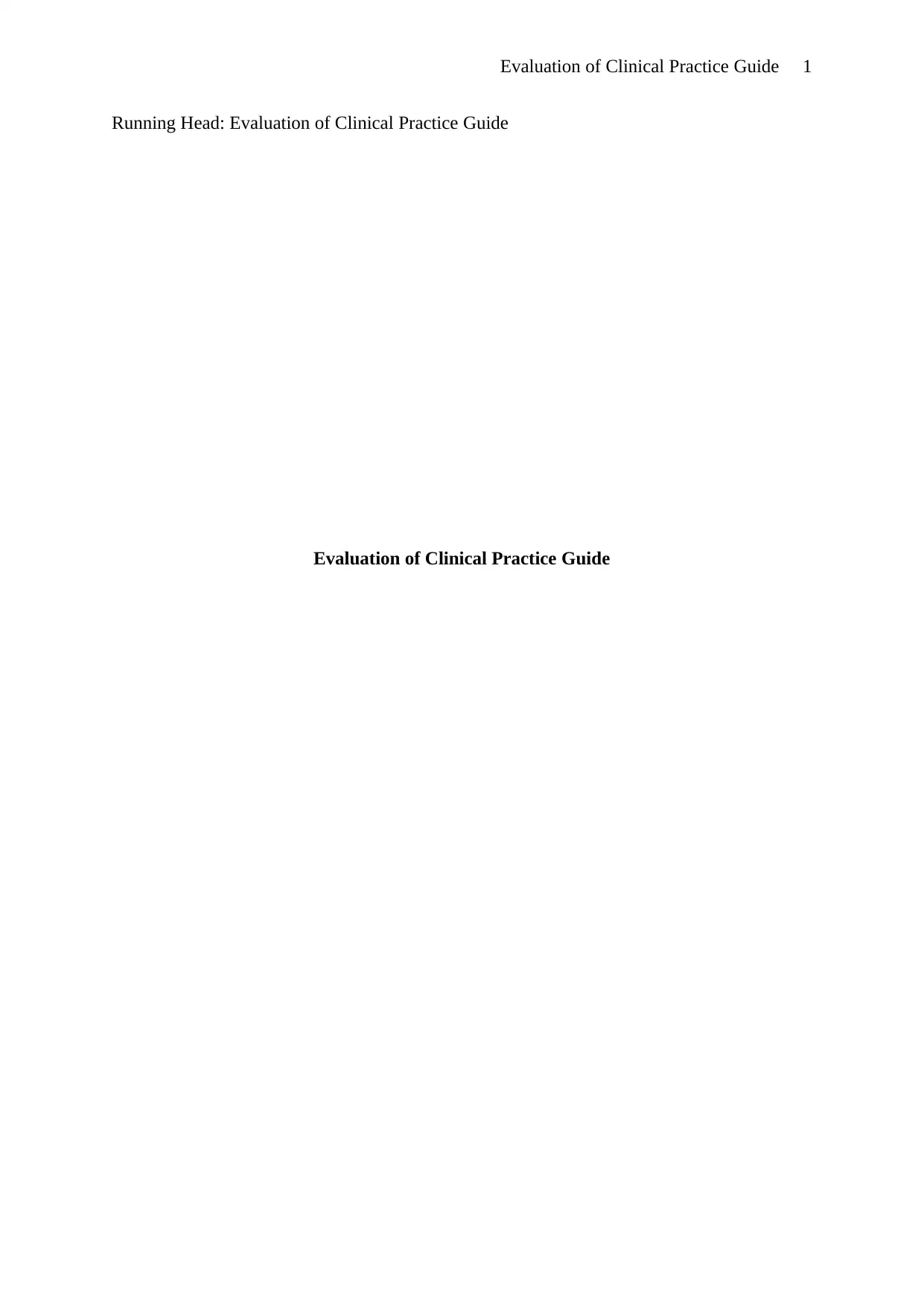
Evaluation of Clinical Practice Guide 1
Running Head: Evaluation of Clinical Practice Guide
Evaluation of Clinical Practice Guide
Running Head: Evaluation of Clinical Practice Guide
Evaluation of Clinical Practice Guide
Paraphrase This Document
Need a fresh take? Get an instant paraphrase of this document with our AI Paraphraser
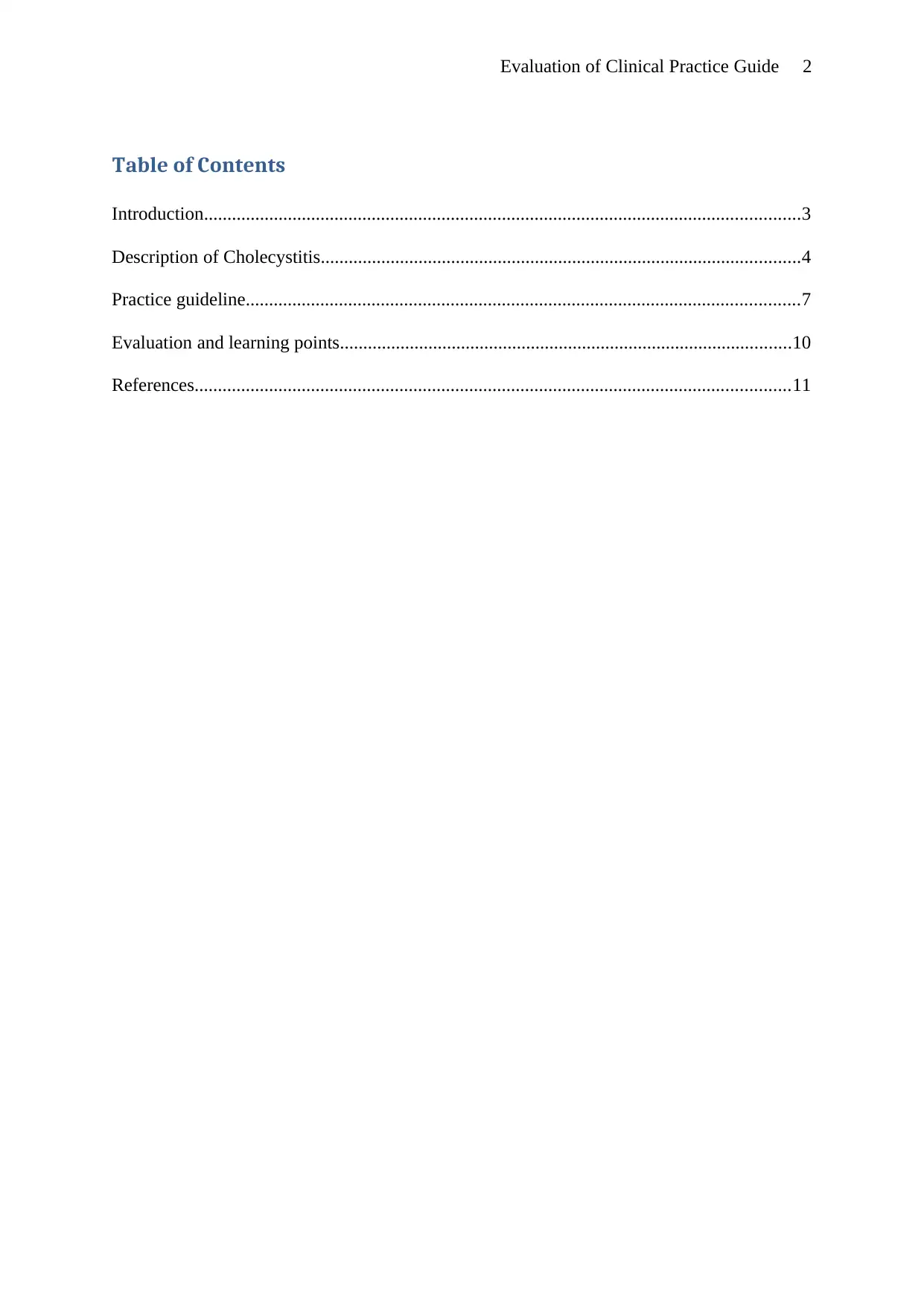
Evaluation of Clinical Practice Guide 2
Table of Contents
Introduction................................................................................................................................3
Description of Cholecystitis.......................................................................................................4
Practice guideline.......................................................................................................................7
Evaluation and learning points.................................................................................................10
References................................................................................................................................11
Table of Contents
Introduction................................................................................................................................3
Description of Cholecystitis.......................................................................................................4
Practice guideline.......................................................................................................................7
Evaluation and learning points.................................................................................................10
References................................................................................................................................11
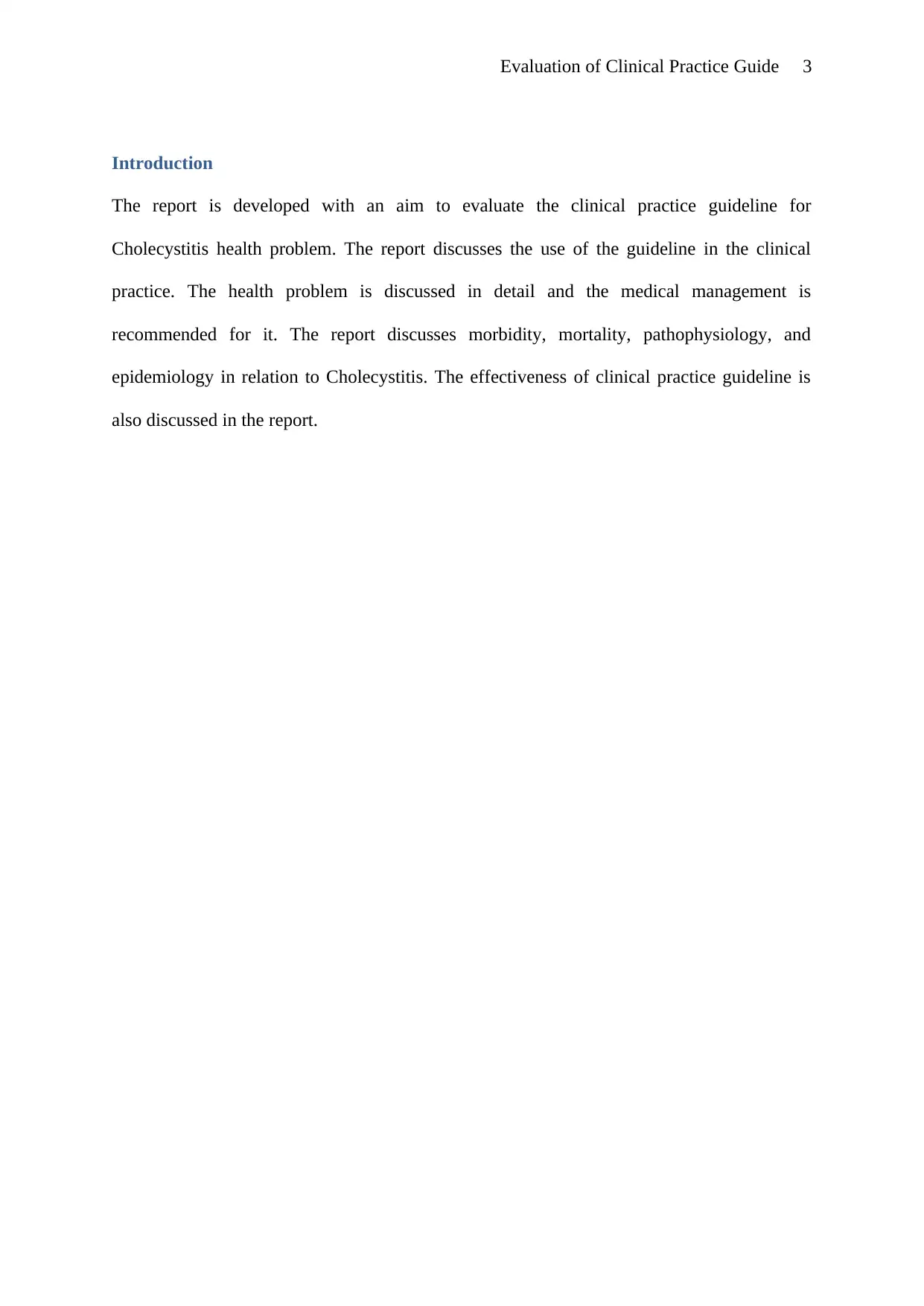
Evaluation of Clinical Practice Guide 3
Introduction
The report is developed with an aim to evaluate the clinical practice guideline for
Cholecystitis health problem. The report discusses the use of the guideline in the clinical
practice. The health problem is discussed in detail and the medical management is
recommended for it. The report discusses morbidity, mortality, pathophysiology, and
epidemiology in relation to Cholecystitis. The effectiveness of clinical practice guideline is
also discussed in the report.
Introduction
The report is developed with an aim to evaluate the clinical practice guideline for
Cholecystitis health problem. The report discusses the use of the guideline in the clinical
practice. The health problem is discussed in detail and the medical management is
recommended for it. The report discusses morbidity, mortality, pathophysiology, and
epidemiology in relation to Cholecystitis. The effectiveness of clinical practice guideline is
also discussed in the report.
⊘ This is a preview!⊘
Do you want full access?
Subscribe today to unlock all pages.

Trusted by 1+ million students worldwide
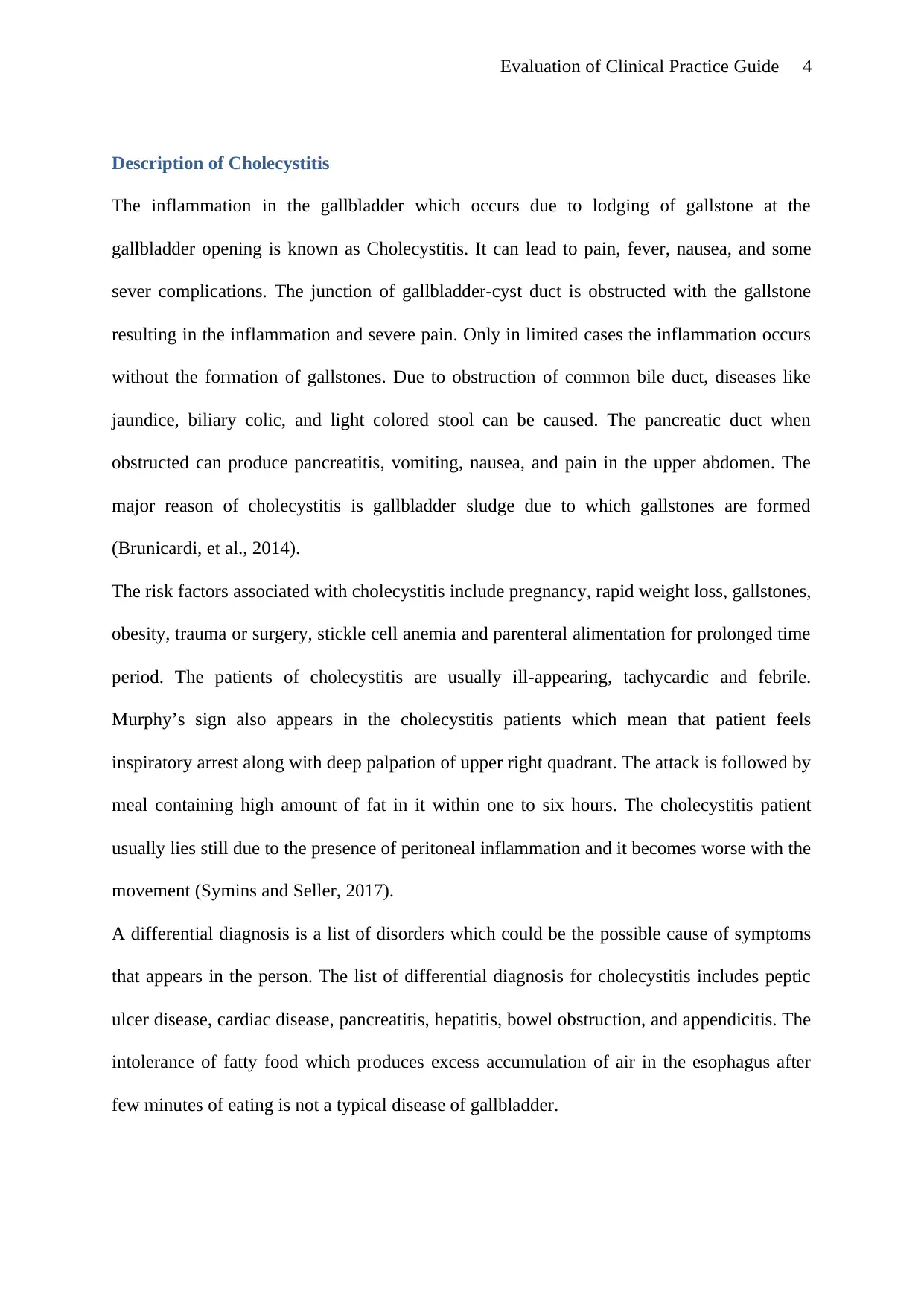
Evaluation of Clinical Practice Guide 4
Description of Cholecystitis
The inflammation in the gallbladder which occurs due to lodging of gallstone at the
gallbladder opening is known as Cholecystitis. It can lead to pain, fever, nausea, and some
sever complications. The junction of gallbladder-cyst duct is obstructed with the gallstone
resulting in the inflammation and severe pain. Only in limited cases the inflammation occurs
without the formation of gallstones. Due to obstruction of common bile duct, diseases like
jaundice, biliary colic, and light colored stool can be caused. The pancreatic duct when
obstructed can produce pancreatitis, vomiting, nausea, and pain in the upper abdomen. The
major reason of cholecystitis is gallbladder sludge due to which gallstones are formed
(Brunicardi, et al., 2014).
The risk factors associated with cholecystitis include pregnancy, rapid weight loss, gallstones,
obesity, trauma or surgery, stickle cell anemia and parenteral alimentation for prolonged time
period. The patients of cholecystitis are usually ill-appearing, tachycardic and febrile.
Murphy’s sign also appears in the cholecystitis patients which mean that patient feels
inspiratory arrest along with deep palpation of upper right quadrant. The attack is followed by
meal containing high amount of fat in it within one to six hours. The cholecystitis patient
usually lies still due to the presence of peritoneal inflammation and it becomes worse with the
movement (Symins and Seller, 2017).
A differential diagnosis is a list of disorders which could be the possible cause of symptoms
that appears in the person. The list of differential diagnosis for cholecystitis includes peptic
ulcer disease, cardiac disease, pancreatitis, hepatitis, bowel obstruction, and appendicitis. The
intolerance of fatty food which produces excess accumulation of air in the esophagus after
few minutes of eating is not a typical disease of gallbladder.
Description of Cholecystitis
The inflammation in the gallbladder which occurs due to lodging of gallstone at the
gallbladder opening is known as Cholecystitis. It can lead to pain, fever, nausea, and some
sever complications. The junction of gallbladder-cyst duct is obstructed with the gallstone
resulting in the inflammation and severe pain. Only in limited cases the inflammation occurs
without the formation of gallstones. Due to obstruction of common bile duct, diseases like
jaundice, biliary colic, and light colored stool can be caused. The pancreatic duct when
obstructed can produce pancreatitis, vomiting, nausea, and pain in the upper abdomen. The
major reason of cholecystitis is gallbladder sludge due to which gallstones are formed
(Brunicardi, et al., 2014).
The risk factors associated with cholecystitis include pregnancy, rapid weight loss, gallstones,
obesity, trauma or surgery, stickle cell anemia and parenteral alimentation for prolonged time
period. The patients of cholecystitis are usually ill-appearing, tachycardic and febrile.
Murphy’s sign also appears in the cholecystitis patients which mean that patient feels
inspiratory arrest along with deep palpation of upper right quadrant. The attack is followed by
meal containing high amount of fat in it within one to six hours. The cholecystitis patient
usually lies still due to the presence of peritoneal inflammation and it becomes worse with the
movement (Symins and Seller, 2017).
A differential diagnosis is a list of disorders which could be the possible cause of symptoms
that appears in the person. The list of differential diagnosis for cholecystitis includes peptic
ulcer disease, cardiac disease, pancreatitis, hepatitis, bowel obstruction, and appendicitis. The
intolerance of fatty food which produces excess accumulation of air in the esophagus after
few minutes of eating is not a typical disease of gallbladder.
Paraphrase This Document
Need a fresh take? Get an instant paraphrase of this document with our AI Paraphraser
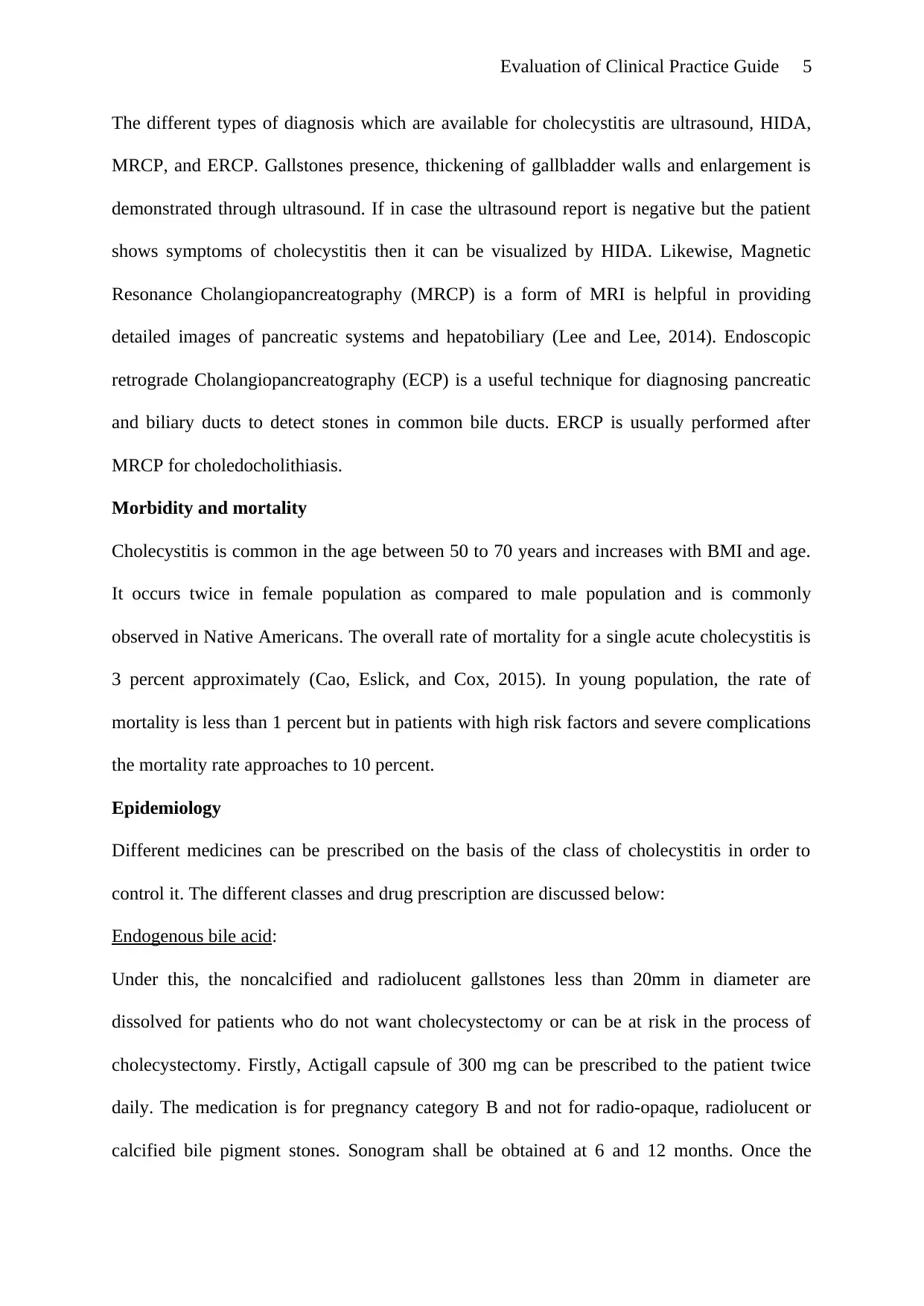
Evaluation of Clinical Practice Guide 5
The different types of diagnosis which are available for cholecystitis are ultrasound, HIDA,
MRCP, and ERCP. Gallstones presence, thickening of gallbladder walls and enlargement is
demonstrated through ultrasound. If in case the ultrasound report is negative but the patient
shows symptoms of cholecystitis then it can be visualized by HIDA. Likewise, Magnetic
Resonance Cholangiopancreatography (MRCP) is a form of MRI is helpful in providing
detailed images of pancreatic systems and hepatobiliary (Lee and Lee, 2014). Endoscopic
retrograde Cholangiopancreatography (ECP) is a useful technique for diagnosing pancreatic
and biliary ducts to detect stones in common bile ducts. ERCP is usually performed after
MRCP for choledocholithiasis.
Morbidity and mortality
Cholecystitis is common in the age between 50 to 70 years and increases with BMI and age.
It occurs twice in female population as compared to male population and is commonly
observed in Native Americans. The overall rate of mortality for a single acute cholecystitis is
3 percent approximately (Cao, Eslick, and Cox, 2015). In young population, the rate of
mortality is less than 1 percent but in patients with high risk factors and severe complications
the mortality rate approaches to 10 percent.
Epidemiology
Different medicines can be prescribed on the basis of the class of cholecystitis in order to
control it. The different classes and drug prescription are discussed below:
Endogenous bile acid:
Under this, the noncalcified and radiolucent gallstones less than 20mm in diameter are
dissolved for patients who do not want cholecystectomy or can be at risk in the process of
cholecystectomy. Firstly, Actigall capsule of 300 mg can be prescribed to the patient twice
daily. The medication is for pregnancy category B and not for radio-opaque, radiolucent or
calcified bile pigment stones. Sonogram shall be obtained at 6 and 12 months. Once the
The different types of diagnosis which are available for cholecystitis are ultrasound, HIDA,
MRCP, and ERCP. Gallstones presence, thickening of gallbladder walls and enlargement is
demonstrated through ultrasound. If in case the ultrasound report is negative but the patient
shows symptoms of cholecystitis then it can be visualized by HIDA. Likewise, Magnetic
Resonance Cholangiopancreatography (MRCP) is a form of MRI is helpful in providing
detailed images of pancreatic systems and hepatobiliary (Lee and Lee, 2014). Endoscopic
retrograde Cholangiopancreatography (ECP) is a useful technique for diagnosing pancreatic
and biliary ducts to detect stones in common bile ducts. ERCP is usually performed after
MRCP for choledocholithiasis.
Morbidity and mortality
Cholecystitis is common in the age between 50 to 70 years and increases with BMI and age.
It occurs twice in female population as compared to male population and is commonly
observed in Native Americans. The overall rate of mortality for a single acute cholecystitis is
3 percent approximately (Cao, Eslick, and Cox, 2015). In young population, the rate of
mortality is less than 1 percent but in patients with high risk factors and severe complications
the mortality rate approaches to 10 percent.
Epidemiology
Different medicines can be prescribed on the basis of the class of cholecystitis in order to
control it. The different classes and drug prescription are discussed below:
Endogenous bile acid:
Under this, the noncalcified and radiolucent gallstones less than 20mm in diameter are
dissolved for patients who do not want cholecystectomy or can be at risk in the process of
cholecystectomy. Firstly, Actigall capsule of 300 mg can be prescribed to the patient twice
daily. The medication is for pregnancy category B and not for radio-opaque, radiolucent or
calcified bile pigment stones. Sonogram shall be obtained at 6 and 12 months. Once the
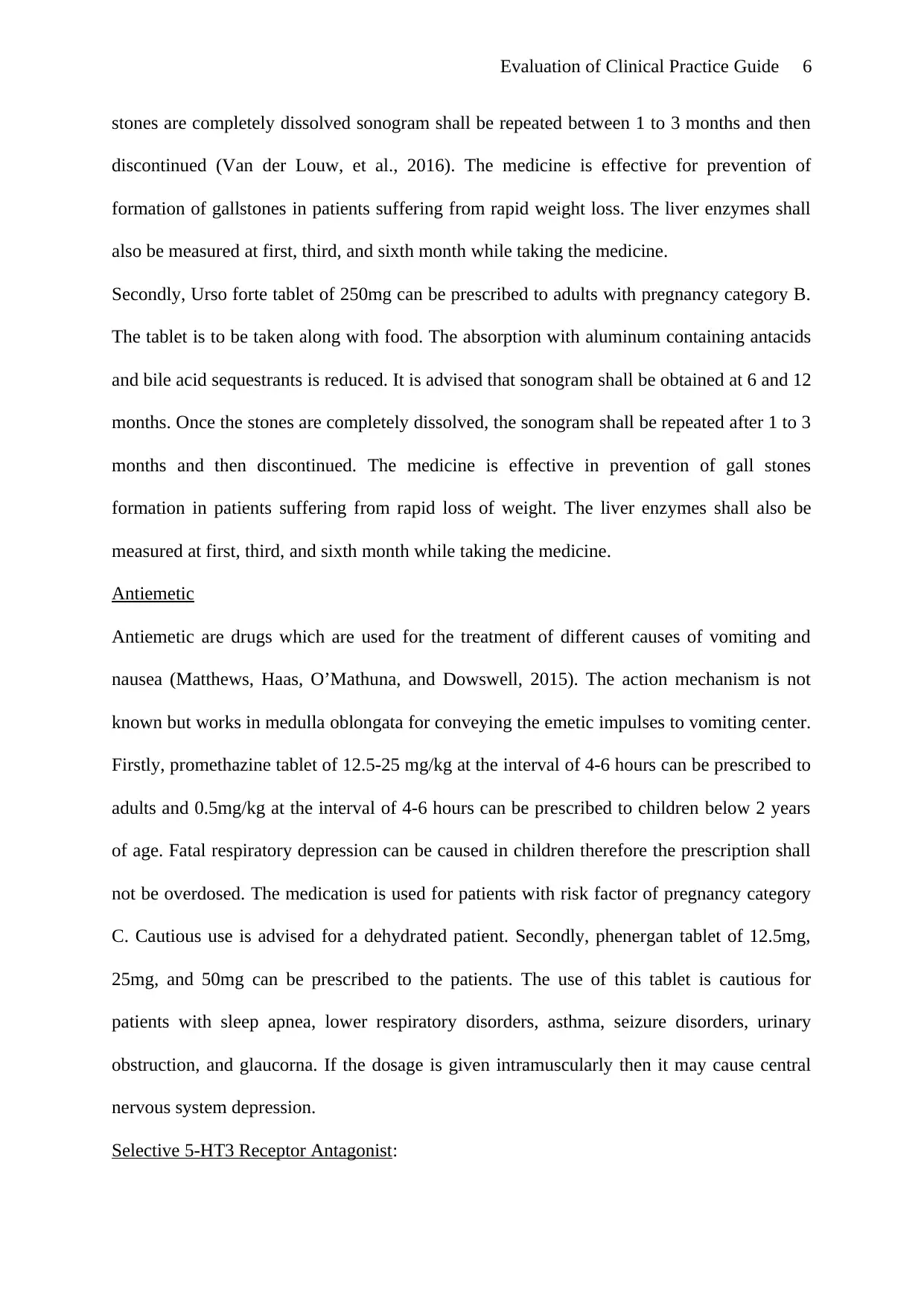
Evaluation of Clinical Practice Guide 6
stones are completely dissolved sonogram shall be repeated between 1 to 3 months and then
discontinued (Van der Louw, et al., 2016). The medicine is effective for prevention of
formation of gallstones in patients suffering from rapid weight loss. The liver enzymes shall
also be measured at first, third, and sixth month while taking the medicine.
Secondly, Urso forte tablet of 250mg can be prescribed to adults with pregnancy category B.
The tablet is to be taken along with food. The absorption with aluminum containing antacids
and bile acid sequestrants is reduced. It is advised that sonogram shall be obtained at 6 and 12
months. Once the stones are completely dissolved, the sonogram shall be repeated after 1 to 3
months and then discontinued. The medicine is effective in prevention of gall stones
formation in patients suffering from rapid loss of weight. The liver enzymes shall also be
measured at first, third, and sixth month while taking the medicine.
Antiemetic
Antiemetic are drugs which are used for the treatment of different causes of vomiting and
nausea (Matthews, Haas, O’Mathuna, and Dowswell, 2015). The action mechanism is not
known but works in medulla oblongata for conveying the emetic impulses to vomiting center.
Firstly, promethazine tablet of 12.5-25 mg/kg at the interval of 4-6 hours can be prescribed to
adults and 0.5mg/kg at the interval of 4-6 hours can be prescribed to children below 2 years
of age. Fatal respiratory depression can be caused in children therefore the prescription shall
not be overdosed. The medication is used for patients with risk factor of pregnancy category
C. Cautious use is advised for a dehydrated patient. Secondly, phenergan tablet of 12.5mg,
25mg, and 50mg can be prescribed to the patients. The use of this tablet is cautious for
patients with sleep apnea, lower respiratory disorders, asthma, seizure disorders, urinary
obstruction, and glaucorna. If the dosage is given intramuscularly then it may cause central
nervous system depression.
Selective 5-HT3 Receptor Antagonist:
stones are completely dissolved sonogram shall be repeated between 1 to 3 months and then
discontinued (Van der Louw, et al., 2016). The medicine is effective for prevention of
formation of gallstones in patients suffering from rapid weight loss. The liver enzymes shall
also be measured at first, third, and sixth month while taking the medicine.
Secondly, Urso forte tablet of 250mg can be prescribed to adults with pregnancy category B.
The tablet is to be taken along with food. The absorption with aluminum containing antacids
and bile acid sequestrants is reduced. It is advised that sonogram shall be obtained at 6 and 12
months. Once the stones are completely dissolved, the sonogram shall be repeated after 1 to 3
months and then discontinued. The medicine is effective in prevention of gall stones
formation in patients suffering from rapid loss of weight. The liver enzymes shall also be
measured at first, third, and sixth month while taking the medicine.
Antiemetic
Antiemetic are drugs which are used for the treatment of different causes of vomiting and
nausea (Matthews, Haas, O’Mathuna, and Dowswell, 2015). The action mechanism is not
known but works in medulla oblongata for conveying the emetic impulses to vomiting center.
Firstly, promethazine tablet of 12.5-25 mg/kg at the interval of 4-6 hours can be prescribed to
adults and 0.5mg/kg at the interval of 4-6 hours can be prescribed to children below 2 years
of age. Fatal respiratory depression can be caused in children therefore the prescription shall
not be overdosed. The medication is used for patients with risk factor of pregnancy category
C. Cautious use is advised for a dehydrated patient. Secondly, phenergan tablet of 12.5mg,
25mg, and 50mg can be prescribed to the patients. The use of this tablet is cautious for
patients with sleep apnea, lower respiratory disorders, asthma, seizure disorders, urinary
obstruction, and glaucorna. If the dosage is given intramuscularly then it may cause central
nervous system depression.
Selective 5-HT3 Receptor Antagonist:
⊘ This is a preview!⊘
Do you want full access?
Subscribe today to unlock all pages.

Trusted by 1+ million students worldwide
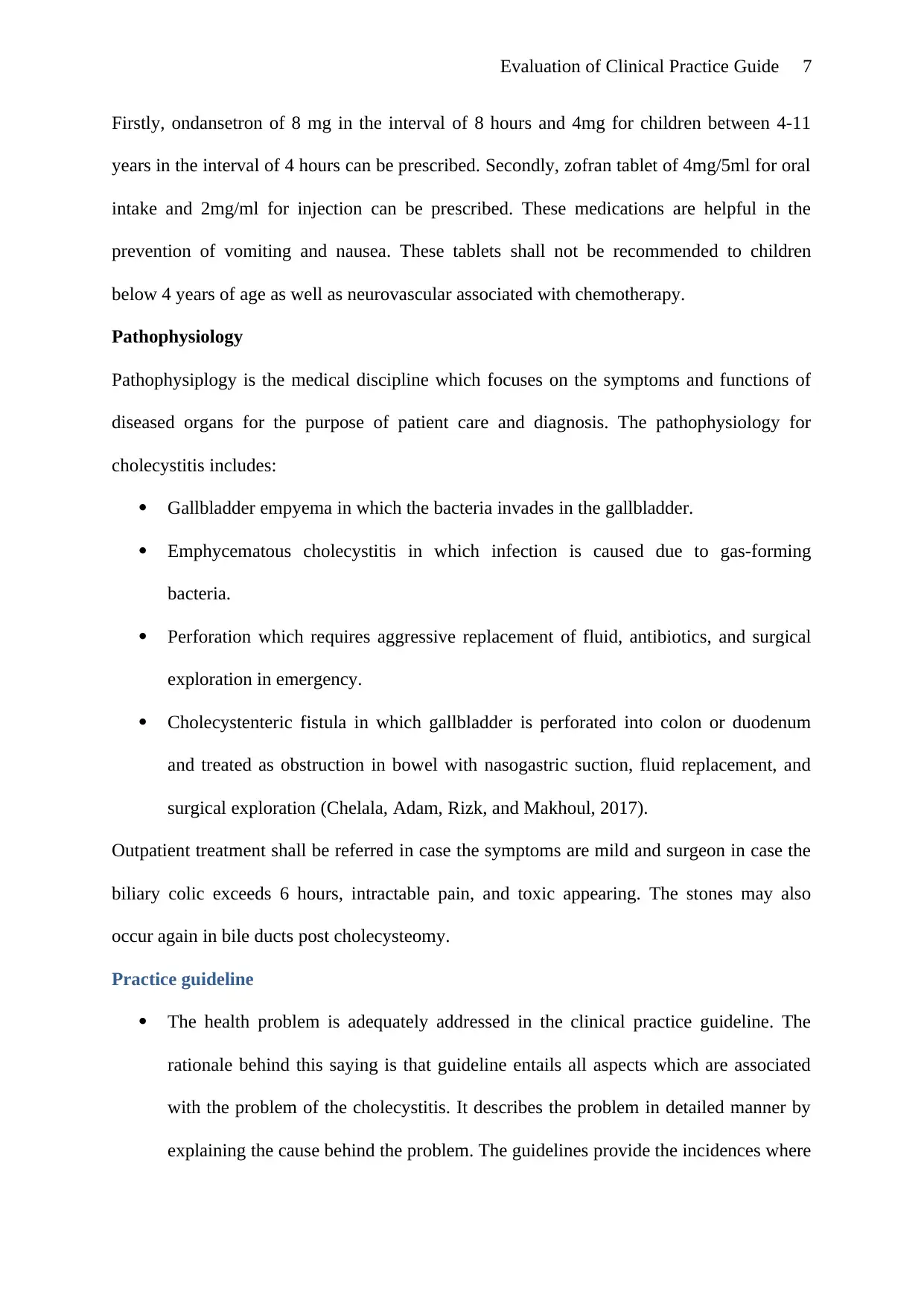
Evaluation of Clinical Practice Guide 7
Firstly, ondansetron of 8 mg in the interval of 8 hours and 4mg for children between 4-11
years in the interval of 4 hours can be prescribed. Secondly, zofran tablet of 4mg/5ml for oral
intake and 2mg/ml for injection can be prescribed. These medications are helpful in the
prevention of vomiting and nausea. These tablets shall not be recommended to children
below 4 years of age as well as neurovascular associated with chemotherapy.
Pathophysiology
Pathophysiplogy is the medical discipline which focuses on the symptoms and functions of
diseased organs for the purpose of patient care and diagnosis. The pathophysiology for
cholecystitis includes:
Gallbladder empyema in which the bacteria invades in the gallbladder.
Emphycematous cholecystitis in which infection is caused due to gas-forming
bacteria.
Perforation which requires aggressive replacement of fluid, antibiotics, and surgical
exploration in emergency.
Cholecystenteric fistula in which gallbladder is perforated into colon or duodenum
and treated as obstruction in bowel with nasogastric suction, fluid replacement, and
surgical exploration (Chelala, Adam, Rizk, and Makhoul, 2017).
Outpatient treatment shall be referred in case the symptoms are mild and surgeon in case the
biliary colic exceeds 6 hours, intractable pain, and toxic appearing. The stones may also
occur again in bile ducts post cholecysteomy.
Practice guideline
The health problem is adequately addressed in the clinical practice guideline. The
rationale behind this saying is that guideline entails all aspects which are associated
with the problem of the cholecystitis. It describes the problem in detailed manner by
explaining the cause behind the problem. The guidelines provide the incidences where
Firstly, ondansetron of 8 mg in the interval of 8 hours and 4mg for children between 4-11
years in the interval of 4 hours can be prescribed. Secondly, zofran tablet of 4mg/5ml for oral
intake and 2mg/ml for injection can be prescribed. These medications are helpful in the
prevention of vomiting and nausea. These tablets shall not be recommended to children
below 4 years of age as well as neurovascular associated with chemotherapy.
Pathophysiology
Pathophysiplogy is the medical discipline which focuses on the symptoms and functions of
diseased organs for the purpose of patient care and diagnosis. The pathophysiology for
cholecystitis includes:
Gallbladder empyema in which the bacteria invades in the gallbladder.
Emphycematous cholecystitis in which infection is caused due to gas-forming
bacteria.
Perforation which requires aggressive replacement of fluid, antibiotics, and surgical
exploration in emergency.
Cholecystenteric fistula in which gallbladder is perforated into colon or duodenum
and treated as obstruction in bowel with nasogastric suction, fluid replacement, and
surgical exploration (Chelala, Adam, Rizk, and Makhoul, 2017).
Outpatient treatment shall be referred in case the symptoms are mild and surgeon in case the
biliary colic exceeds 6 hours, intractable pain, and toxic appearing. The stones may also
occur again in bile ducts post cholecysteomy.
Practice guideline
The health problem is adequately addressed in the clinical practice guideline. The
rationale behind this saying is that guideline entails all aspects which are associated
with the problem of the cholecystitis. It describes the problem in detailed manner by
explaining the cause behind the problem. The guidelines provide the incidences where
Paraphrase This Document
Need a fresh take? Get an instant paraphrase of this document with our AI Paraphraser
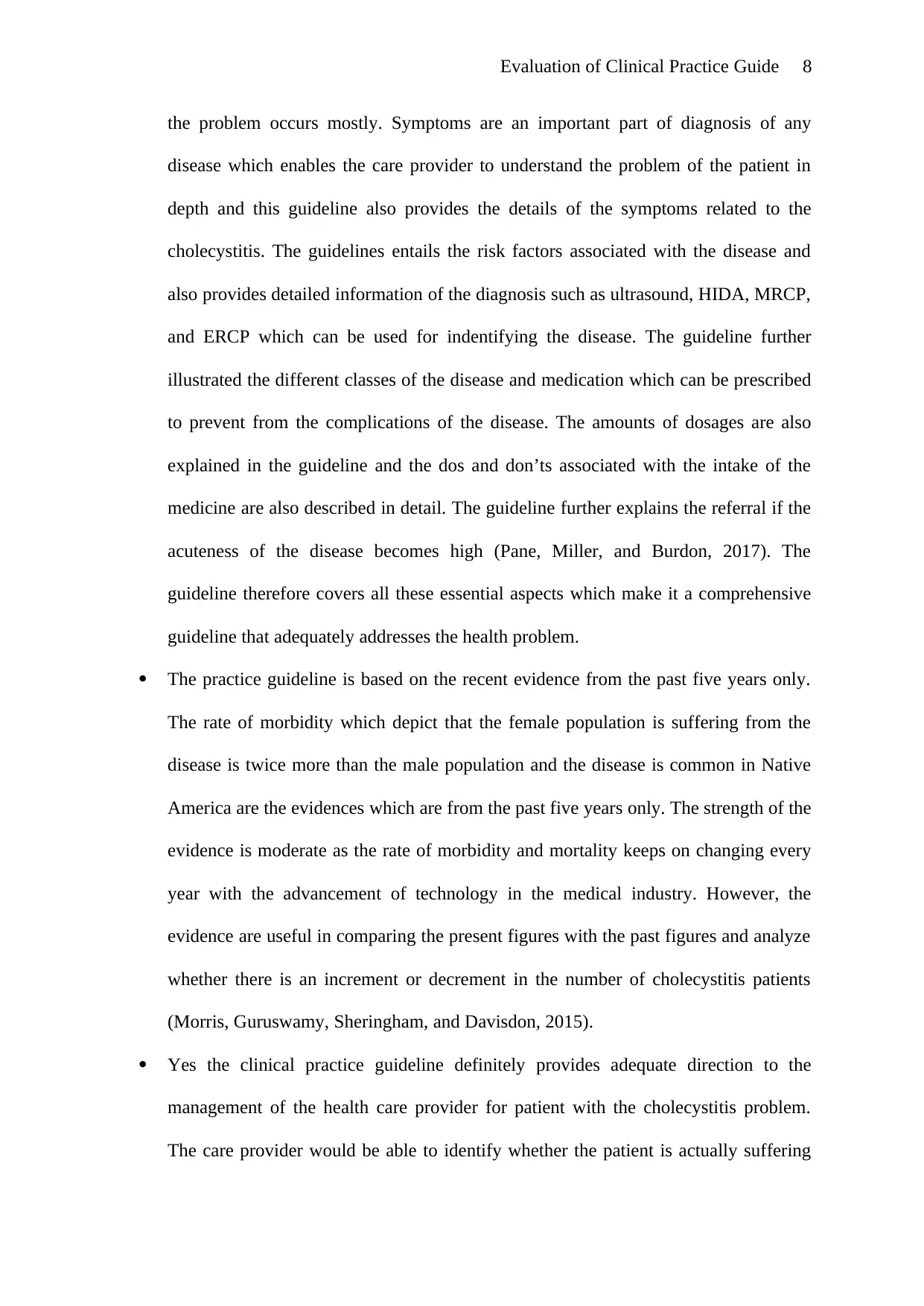
Evaluation of Clinical Practice Guide 8
the problem occurs mostly. Symptoms are an important part of diagnosis of any
disease which enables the care provider to understand the problem of the patient in
depth and this guideline also provides the details of the symptoms related to the
cholecystitis. The guidelines entails the risk factors associated with the disease and
also provides detailed information of the diagnosis such as ultrasound, HIDA, MRCP,
and ERCP which can be used for indentifying the disease. The guideline further
illustrated the different classes of the disease and medication which can be prescribed
to prevent from the complications of the disease. The amounts of dosages are also
explained in the guideline and the dos and don’ts associated with the intake of the
medicine are also described in detail. The guideline further explains the referral if the
acuteness of the disease becomes high (Pane, Miller, and Burdon, 2017). The
guideline therefore covers all these essential aspects which make it a comprehensive
guideline that adequately addresses the health problem.
The practice guideline is based on the recent evidence from the past five years only.
The rate of morbidity which depict that the female population is suffering from the
disease is twice more than the male population and the disease is common in Native
America are the evidences which are from the past five years only. The strength of the
evidence is moderate as the rate of morbidity and mortality keeps on changing every
year with the advancement of technology in the medical industry. However, the
evidence are useful in comparing the present figures with the past figures and analyze
whether there is an increment or decrement in the number of cholecystitis patients
(Morris, Guruswamy, Sheringham, and Davisdon, 2015).
Yes the clinical practice guideline definitely provides adequate direction to the
management of the health care provider for patient with the cholecystitis problem.
The care provider would be able to identify whether the patient is actually suffering
the problem occurs mostly. Symptoms are an important part of diagnosis of any
disease which enables the care provider to understand the problem of the patient in
depth and this guideline also provides the details of the symptoms related to the
cholecystitis. The guidelines entails the risk factors associated with the disease and
also provides detailed information of the diagnosis such as ultrasound, HIDA, MRCP,
and ERCP which can be used for indentifying the disease. The guideline further
illustrated the different classes of the disease and medication which can be prescribed
to prevent from the complications of the disease. The amounts of dosages are also
explained in the guideline and the dos and don’ts associated with the intake of the
medicine are also described in detail. The guideline further explains the referral if the
acuteness of the disease becomes high (Pane, Miller, and Burdon, 2017). The
guideline therefore covers all these essential aspects which make it a comprehensive
guideline that adequately addresses the health problem.
The practice guideline is based on the recent evidence from the past five years only.
The rate of morbidity which depict that the female population is suffering from the
disease is twice more than the male population and the disease is common in Native
America are the evidences which are from the past five years only. The strength of the
evidence is moderate as the rate of morbidity and mortality keeps on changing every
year with the advancement of technology in the medical industry. However, the
evidence are useful in comparing the present figures with the past figures and analyze
whether there is an increment or decrement in the number of cholecystitis patients
(Morris, Guruswamy, Sheringham, and Davisdon, 2015).
Yes the clinical practice guideline definitely provides adequate direction to the
management of the health care provider for patient with the cholecystitis problem.
The care provider would be able to identify whether the patient is actually suffering
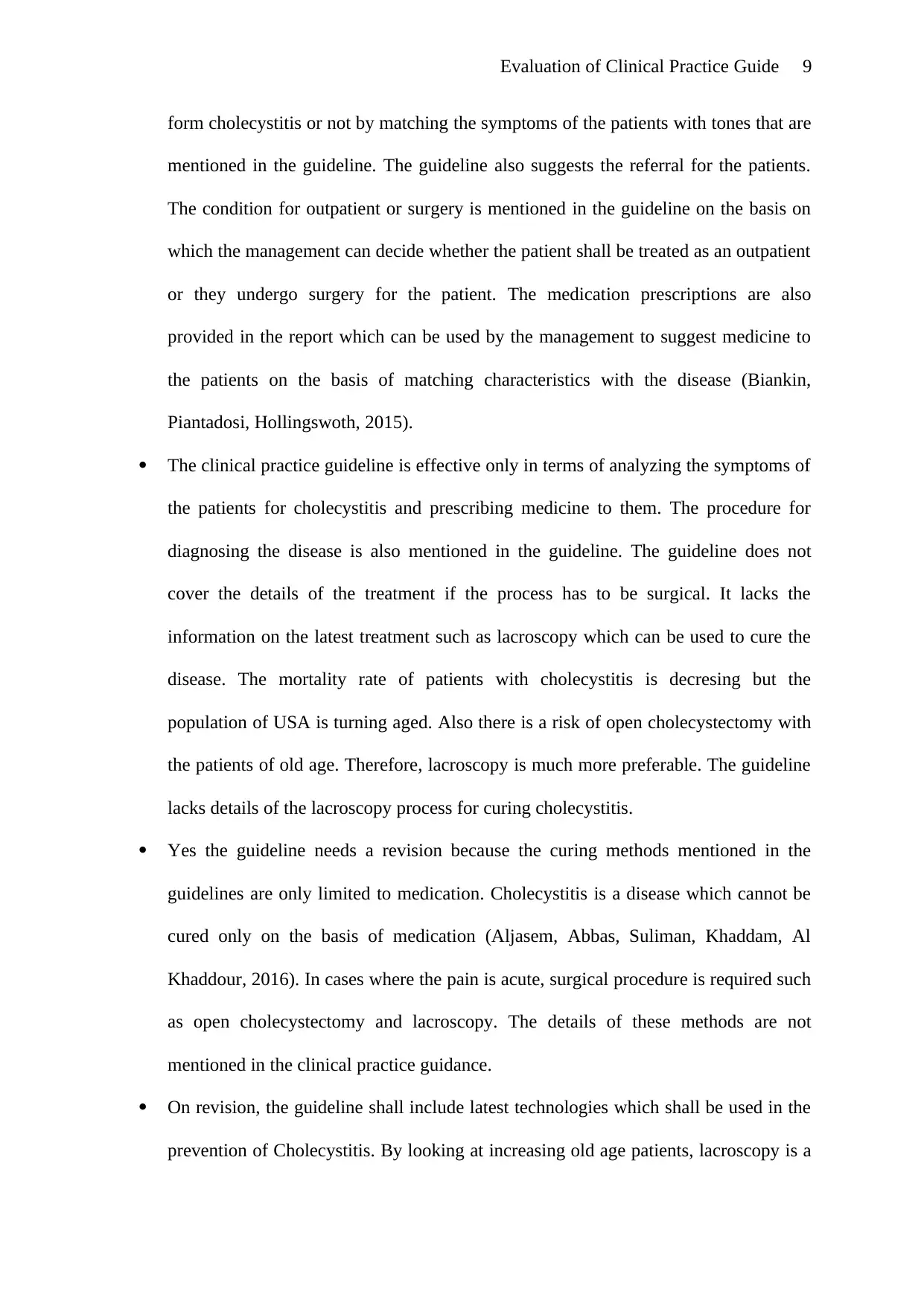
Evaluation of Clinical Practice Guide 9
form cholecystitis or not by matching the symptoms of the patients with tones that are
mentioned in the guideline. The guideline also suggests the referral for the patients.
The condition for outpatient or surgery is mentioned in the guideline on the basis on
which the management can decide whether the patient shall be treated as an outpatient
or they undergo surgery for the patient. The medication prescriptions are also
provided in the report which can be used by the management to suggest medicine to
the patients on the basis of matching characteristics with the disease (Biankin,
Piantadosi, Hollingswoth, 2015).
The clinical practice guideline is effective only in terms of analyzing the symptoms of
the patients for cholecystitis and prescribing medicine to them. The procedure for
diagnosing the disease is also mentioned in the guideline. The guideline does not
cover the details of the treatment if the process has to be surgical. It lacks the
information on the latest treatment such as lacroscopy which can be used to cure the
disease. The mortality rate of patients with cholecystitis is decresing but the
population of USA is turning aged. Also there is a risk of open cholecystectomy with
the patients of old age. Therefore, lacroscopy is much more preferable. The guideline
lacks details of the lacroscopy process for curing cholecystitis.
Yes the guideline needs a revision because the curing methods mentioned in the
guidelines are only limited to medication. Cholecystitis is a disease which cannot be
cured only on the basis of medication (Aljasem, Abbas, Suliman, Khaddam, Al
Khaddour, 2016). In cases where the pain is acute, surgical procedure is required such
as open cholecystectomy and lacroscopy. The details of these methods are not
mentioned in the clinical practice guidance.
On revision, the guideline shall include latest technologies which shall be used in the
prevention of Cholecystitis. By looking at increasing old age patients, lacroscopy is a
form cholecystitis or not by matching the symptoms of the patients with tones that are
mentioned in the guideline. The guideline also suggests the referral for the patients.
The condition for outpatient or surgery is mentioned in the guideline on the basis on
which the management can decide whether the patient shall be treated as an outpatient
or they undergo surgery for the patient. The medication prescriptions are also
provided in the report which can be used by the management to suggest medicine to
the patients on the basis of matching characteristics with the disease (Biankin,
Piantadosi, Hollingswoth, 2015).
The clinical practice guideline is effective only in terms of analyzing the symptoms of
the patients for cholecystitis and prescribing medicine to them. The procedure for
diagnosing the disease is also mentioned in the guideline. The guideline does not
cover the details of the treatment if the process has to be surgical. It lacks the
information on the latest treatment such as lacroscopy which can be used to cure the
disease. The mortality rate of patients with cholecystitis is decresing but the
population of USA is turning aged. Also there is a risk of open cholecystectomy with
the patients of old age. Therefore, lacroscopy is much more preferable. The guideline
lacks details of the lacroscopy process for curing cholecystitis.
Yes the guideline needs a revision because the curing methods mentioned in the
guidelines are only limited to medication. Cholecystitis is a disease which cannot be
cured only on the basis of medication (Aljasem, Abbas, Suliman, Khaddam, Al
Khaddour, 2016). In cases where the pain is acute, surgical procedure is required such
as open cholecystectomy and lacroscopy. The details of these methods are not
mentioned in the clinical practice guidance.
On revision, the guideline shall include latest technologies which shall be used in the
prevention of Cholecystitis. By looking at increasing old age patients, lacroscopy is a
⊘ This is a preview!⊘
Do you want full access?
Subscribe today to unlock all pages.

Trusted by 1+ million students worldwide
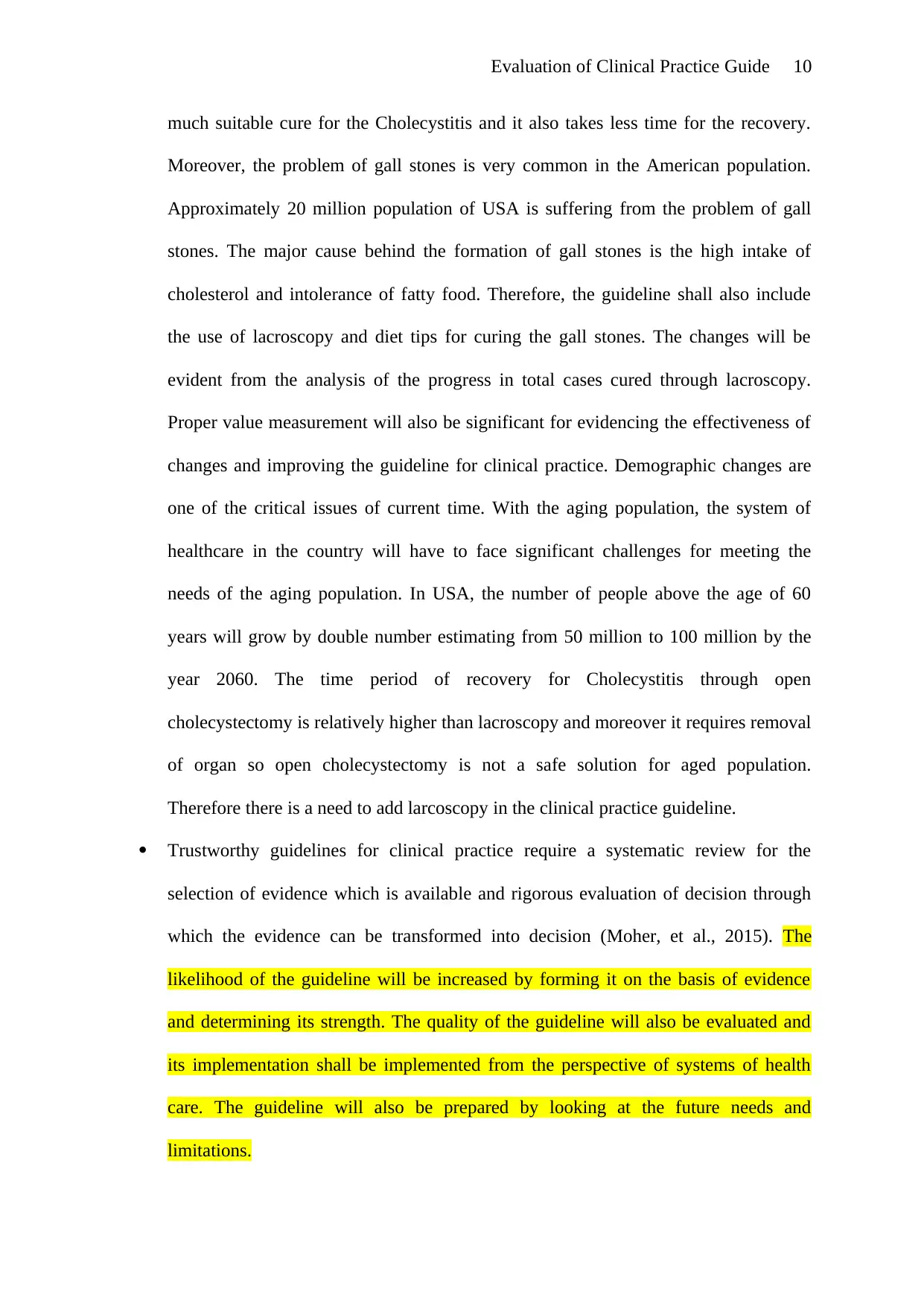
Evaluation of Clinical Practice Guide 10
much suitable cure for the Cholecystitis and it also takes less time for the recovery.
Moreover, the problem of gall stones is very common in the American population.
Approximately 20 million population of USA is suffering from the problem of gall
stones. The major cause behind the formation of gall stones is the high intake of
cholesterol and intolerance of fatty food. Therefore, the guideline shall also include
the use of lacroscopy and diet tips for curing the gall stones. The changes will be
evident from the analysis of the progress in total cases cured through lacroscopy.
Proper value measurement will also be significant for evidencing the effectiveness of
changes and improving the guideline for clinical practice. Demographic changes are
one of the critical issues of current time. With the aging population, the system of
healthcare in the country will have to face significant challenges for meeting the
needs of the aging population. In USA, the number of people above the age of 60
years will grow by double number estimating from 50 million to 100 million by the
year 2060. The time period of recovery for Cholecystitis through open
cholecystectomy is relatively higher than lacroscopy and moreover it requires removal
of organ so open cholecystectomy is not a safe solution for aged population.
Therefore there is a need to add larcoscopy in the clinical practice guideline.
Trustworthy guidelines for clinical practice require a systematic review for the
selection of evidence which is available and rigorous evaluation of decision through
which the evidence can be transformed into decision (Moher, et al., 2015). The
likelihood of the guideline will be increased by forming it on the basis of evidence
and determining its strength. The quality of the guideline will also be evaluated and
its implementation shall be implemented from the perspective of systems of health
care. The guideline will also be prepared by looking at the future needs and
limitations.
much suitable cure for the Cholecystitis and it also takes less time for the recovery.
Moreover, the problem of gall stones is very common in the American population.
Approximately 20 million population of USA is suffering from the problem of gall
stones. The major cause behind the formation of gall stones is the high intake of
cholesterol and intolerance of fatty food. Therefore, the guideline shall also include
the use of lacroscopy and diet tips for curing the gall stones. The changes will be
evident from the analysis of the progress in total cases cured through lacroscopy.
Proper value measurement will also be significant for evidencing the effectiveness of
changes and improving the guideline for clinical practice. Demographic changes are
one of the critical issues of current time. With the aging population, the system of
healthcare in the country will have to face significant challenges for meeting the
needs of the aging population. In USA, the number of people above the age of 60
years will grow by double number estimating from 50 million to 100 million by the
year 2060. The time period of recovery for Cholecystitis through open
cholecystectomy is relatively higher than lacroscopy and moreover it requires removal
of organ so open cholecystectomy is not a safe solution for aged population.
Therefore there is a need to add larcoscopy in the clinical practice guideline.
Trustworthy guidelines for clinical practice require a systematic review for the
selection of evidence which is available and rigorous evaluation of decision through
which the evidence can be transformed into decision (Moher, et al., 2015). The
likelihood of the guideline will be increased by forming it on the basis of evidence
and determining its strength. The quality of the guideline will also be evaluated and
its implementation shall be implemented from the perspective of systems of health
care. The guideline will also be prepared by looking at the future needs and
limitations.
Paraphrase This Document
Need a fresh take? Get an instant paraphrase of this document with our AI Paraphraser
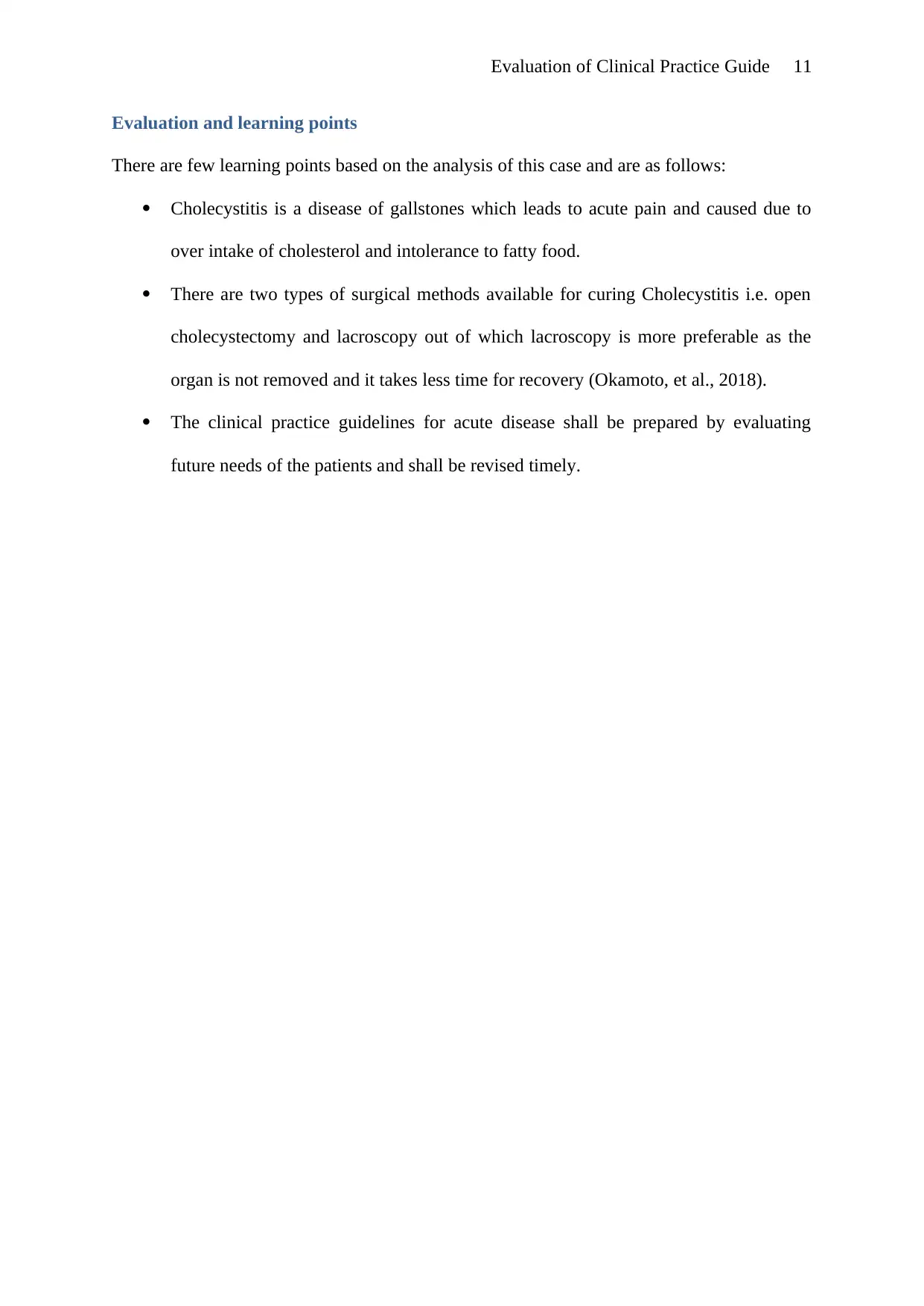
Evaluation of Clinical Practice Guide 11
Evaluation and learning points
There are few learning points based on the analysis of this case and are as follows:
Cholecystitis is a disease of gallstones which leads to acute pain and caused due to
over intake of cholesterol and intolerance to fatty food.
There are two types of surgical methods available for curing Cholecystitis i.e. open
cholecystectomy and lacroscopy out of which lacroscopy is more preferable as the
organ is not removed and it takes less time for recovery (Okamoto, et al., 2018).
The clinical practice guidelines for acute disease shall be prepared by evaluating
future needs of the patients and shall be revised timely.
Evaluation and learning points
There are few learning points based on the analysis of this case and are as follows:
Cholecystitis is a disease of gallstones which leads to acute pain and caused due to
over intake of cholesterol and intolerance to fatty food.
There are two types of surgical methods available for curing Cholecystitis i.e. open
cholecystectomy and lacroscopy out of which lacroscopy is more preferable as the
organ is not removed and it takes less time for recovery (Okamoto, et al., 2018).
The clinical practice guidelines for acute disease shall be prepared by evaluating
future needs of the patients and shall be revised timely.
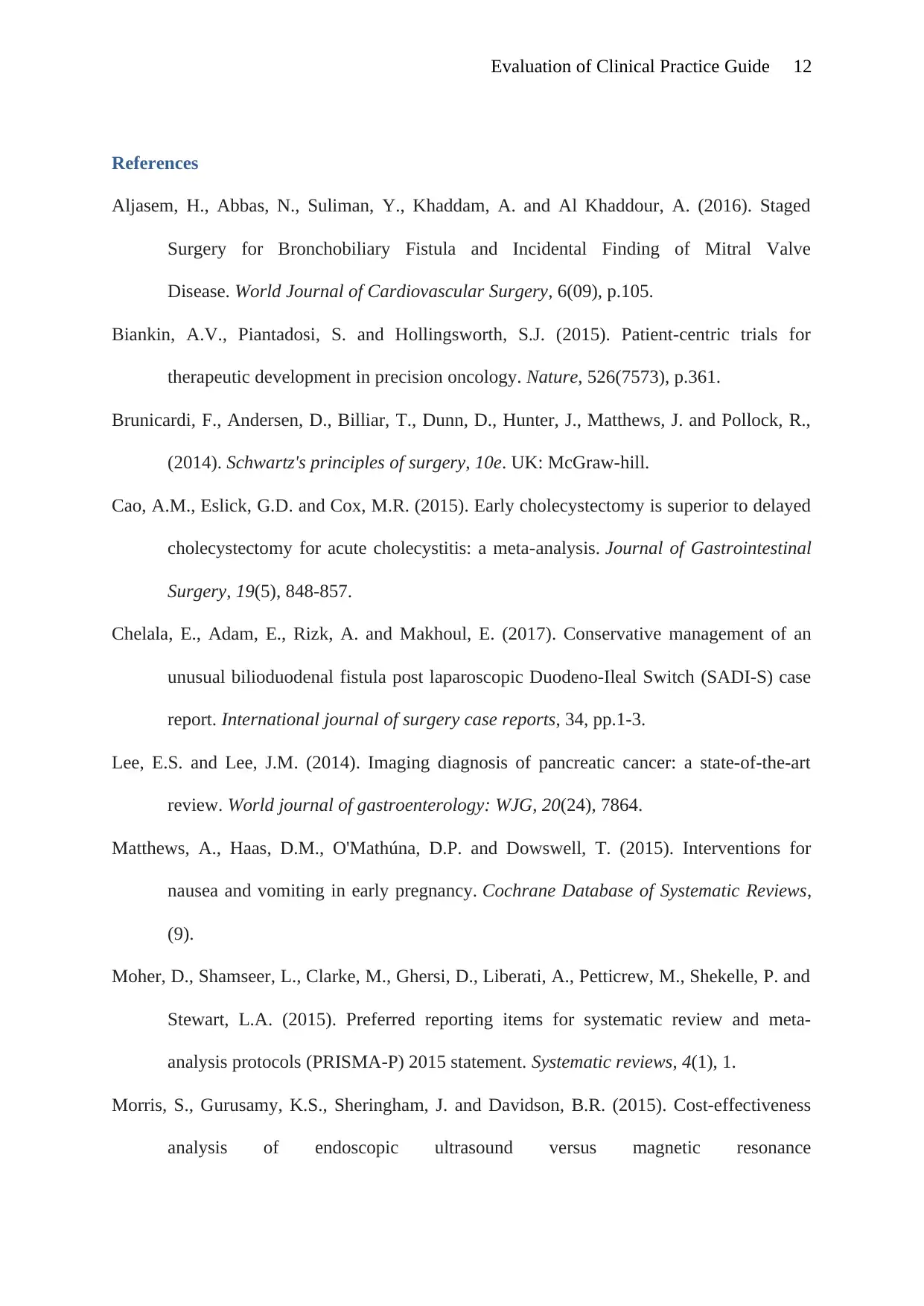
Evaluation of Clinical Practice Guide 12
References
Aljasem, H., Abbas, N., Suliman, Y., Khaddam, A. and Al Khaddour, A. (2016). Staged
Surgery for Bronchobiliary Fistula and Incidental Finding of Mitral Valve
Disease. World Journal of Cardiovascular Surgery, 6(09), p.105.
Biankin, A.V., Piantadosi, S. and Hollingsworth, S.J. (2015). Patient-centric trials for
therapeutic development in precision oncology. Nature, 526(7573), p.361.
Brunicardi, F., Andersen, D., Billiar, T., Dunn, D., Hunter, J., Matthews, J. and Pollock, R.,
(2014). Schwartz's principles of surgery, 10e. UK: McGraw-hill.
Cao, A.M., Eslick, G.D. and Cox, M.R. (2015). Early cholecystectomy is superior to delayed
cholecystectomy for acute cholecystitis: a meta-analysis. Journal of Gastrointestinal
Surgery, 19(5), 848-857.
Chelala, E., Adam, E., Rizk, A. and Makhoul, E. (2017). Conservative management of an
unusual bilioduodenal fistula post laparoscopic Duodeno-Ileal Switch (SADI-S) case
report. International journal of surgery case reports, 34, pp.1-3.
Lee, E.S. and Lee, J.M. (2014). Imaging diagnosis of pancreatic cancer: a state-of-the-art
review. World journal of gastroenterology: WJG, 20(24), 7864.
Matthews, A., Haas, D.M., O'Mathúna, D.P. and Dowswell, T. (2015). Interventions for
nausea and vomiting in early pregnancy. Cochrane Database of Systematic Reviews,
(9).
Moher, D., Shamseer, L., Clarke, M., Ghersi, D., Liberati, A., Petticrew, M., Shekelle, P. and
Stewart, L.A. (2015). Preferred reporting items for systematic review and meta-
analysis protocols (PRISMA-P) 2015 statement. Systematic reviews, 4(1), 1.
Morris, S., Gurusamy, K.S., Sheringham, J. and Davidson, B.R. (2015). Cost-effectiveness
analysis of endoscopic ultrasound versus magnetic resonance
References
Aljasem, H., Abbas, N., Suliman, Y., Khaddam, A. and Al Khaddour, A. (2016). Staged
Surgery for Bronchobiliary Fistula and Incidental Finding of Mitral Valve
Disease. World Journal of Cardiovascular Surgery, 6(09), p.105.
Biankin, A.V., Piantadosi, S. and Hollingsworth, S.J. (2015). Patient-centric trials for
therapeutic development in precision oncology. Nature, 526(7573), p.361.
Brunicardi, F., Andersen, D., Billiar, T., Dunn, D., Hunter, J., Matthews, J. and Pollock, R.,
(2014). Schwartz's principles of surgery, 10e. UK: McGraw-hill.
Cao, A.M., Eslick, G.D. and Cox, M.R. (2015). Early cholecystectomy is superior to delayed
cholecystectomy for acute cholecystitis: a meta-analysis. Journal of Gastrointestinal
Surgery, 19(5), 848-857.
Chelala, E., Adam, E., Rizk, A. and Makhoul, E. (2017). Conservative management of an
unusual bilioduodenal fistula post laparoscopic Duodeno-Ileal Switch (SADI-S) case
report. International journal of surgery case reports, 34, pp.1-3.
Lee, E.S. and Lee, J.M. (2014). Imaging diagnosis of pancreatic cancer: a state-of-the-art
review. World journal of gastroenterology: WJG, 20(24), 7864.
Matthews, A., Haas, D.M., O'Mathúna, D.P. and Dowswell, T. (2015). Interventions for
nausea and vomiting in early pregnancy. Cochrane Database of Systematic Reviews,
(9).
Moher, D., Shamseer, L., Clarke, M., Ghersi, D., Liberati, A., Petticrew, M., Shekelle, P. and
Stewart, L.A. (2015). Preferred reporting items for systematic review and meta-
analysis protocols (PRISMA-P) 2015 statement. Systematic reviews, 4(1), 1.
Morris, S., Gurusamy, K.S., Sheringham, J. and Davidson, B.R. (2015). Cost-effectiveness
analysis of endoscopic ultrasound versus magnetic resonance
⊘ This is a preview!⊘
Do you want full access?
Subscribe today to unlock all pages.

Trusted by 1+ million students worldwide
1 out of 13
Related Documents
Your All-in-One AI-Powered Toolkit for Academic Success.
+13062052269
info@desklib.com
Available 24*7 on WhatsApp / Email
![[object Object]](/_next/static/media/star-bottom.7253800d.svg)
Unlock your academic potential
Copyright © 2020–2025 A2Z Services. All Rights Reserved. Developed and managed by ZUCOL.





